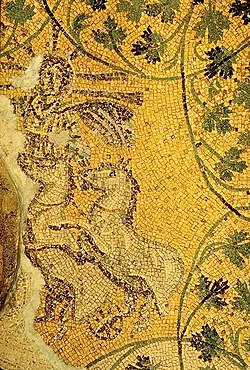| Revision as of 15:46, 18 December 2024 editAntiDionysius (talk | contribs)Extended confirmed users, Pending changes reviewers, Rollbackers39,318 editsm Reverted edits by 2.32.6.171 (talk) to last version by HeythereimaguyTag: Rollback← Previous edit | Revision as of 15:52, 18 December 2024 edit undo2.32.6.171 (talk)No edit summaryTags: Reverted references removed Mobile edit Mobile web editNext edit → | ||
| Line 13: | Line 13: | ||
| }} | }} | ||
| The popularly named "'''Tomb of the Julii'''" (Mausoleum "M") survives in the ] beneath ]. The serendipitous discovery near the ] has a vaulted ceiling bearing a ] depicting |
The popularly named "'''Tomb of the Julii'''" (Mausoleum "M") survives in the ] beneath ]. The serendipitous discovery near the ] has a vaulted ceiling bearing a ] depicting ] as ] with an ] riding in his ], within a framing of rinceaux of vine leaves. The surrounding mosaics also contain ] iconography, such as Jonah and the whale, the good shepherd carrying a lamb (the '']'' motif), and fishermen. Due to these symbols, the tomb is interpreted as an early Christian vault.<ref>{{cite book |last = Beckwith |first = John | author-link = John Beckwith (curator) |date = 1979 |title = Early Christian and Byzantine art |edition= 2nd (integrated) |url = https://archive.org/details/earlychristianby0000beck/page/n3/mode/2up |location = London, England | publisher = Penguin Books |page = 19 | isbn = 0140560335}}</ref> | ||
| Age of spirituality: late antique and early Christian art, third to seventh century; catalogue of the exhibition at the Metropolitan Museum of Art, November 19, 1977 through Febuary 12, 1978 |quote = When the artists of the mosaics of the tomb of the Julii under St. Peter's (no.467) portrayed Christ with a rayed nimbus, like Helios in a quadrigia ascending to heaven, he was quoting imagery of Sol Invictus, whose cult was favoured by late Roman Emperors. |url = https://libmma.contentdm.oclc.org/digital/collection/p15324coll10/id/156308 |location = New York, New York, USA| publisher = in association with the Princeton University Press |page = 531-532| isbn = 0870991795 }}<!--also available on the internet archive: https://archive.org/details/AgeOfSpiritualityLateAntiqueAndEarlyChristianArtThirdToSeventhCentury_201404 --></ref> within a framing of rinceaux of vine leaves. The surrounding ] iconography, such as other mosaics in this tomb depicting Jonah and the whale, the good shepherd carrying a lamb (the '']'' motif), and fishermen have led to an interpretation of the deity as ], known in this form as "Christus-Sol". Due to these symbols, the tomb is interpreted as an early Christian vault.<ref>{{cite book |last = Beckwith |first = John | author-link = John Beckwith (curator) |date = 1979 |title = Early Christian and Byzantine art |edition= 2nd (integrated) |url = https://archive.org/details/earlychristianby0000beck/page/n3/mode/2up |location = London, England | publisher = Penguin Books |page = 19 | isbn = 0140560335}}</ref> | |||
| This tomb was first discovered in 1574 AD when workmen accidentally broke through the ceiling while conducting some floor alterations in the basilica. The inside was briefly explored and documented before the opening was sealed over once more.<ref>{{cite book |last = Evangelist Walsh |first = John | author-link = John Evangelist Walsh |date = 1985 |title = The Bones of St. Peter: The First Full Account of the Search for the Apostles Body |url = https://archive.org/details/bonesofstpeter00wals/page/n7/mode/2up |location = Garden City, New York | publisher = Image Books |page = 15 | isbn = 978-1933184753}} <!-- should internet archive go down, internet copy can be found here: https://stpetersbasilica.info/Necropolis/JW/TheBonesofStPeter-1.htm --></ref> | This tomb was first discovered in 1574 AD when workmen accidentally broke through the ceiling while conducting some floor alterations in the basilica. The inside was briefly explored and documented before the opening was sealed over once more.<ref>{{cite book |last = Evangelist Walsh |first = John | author-link = John Evangelist Walsh |date = 1985 |title = The Bones of St. Peter: The First Full Account of the Search for the Apostles Body |url = https://archive.org/details/bonesofstpeter00wals/page/n7/mode/2up |location = Garden City, New York | publisher = Image Books |page = 15 | isbn = 978-1933184753}} <!-- should internet archive go down, internet copy can be found here: https://stpetersbasilica.info/Necropolis/JW/TheBonesofStPeter-1.htm --></ref> | ||
Revision as of 15:52, 18 December 2024
Part of the Vatican Necropolis| Tomb of the Julii | |
|---|---|
 Detail of the mosaic Detail of the mosaic | |
| Click on the map for a fullscreen view | |
| General information | |
| Location | Vatican City |
| Coordinates | 41°54′8″N 12°27′12″E / 41.90222°N 12.45333°E / 41.90222; 12.45333 |
The popularly named "Tomb of the Julii" (Mausoleum "M") survives in the Vatican Necropolis beneath St. Peter's Basilica. The serendipitous discovery near the crypt has a vaulted ceiling bearing a mosaic depicting Apollo as Jesus with an aureole riding in his chariot, within a framing of rinceaux of vine leaves. The surrounding mosaics also contain Christian iconography, such as Jonah and the whale, the good shepherd carrying a lamb (the kriophoros motif), and fishermen. Due to these symbols, the tomb is interpreted as an early Christian vault.
This tomb was first discovered in 1574 AD when workmen accidentally broke through the ceiling while conducting some floor alterations in the basilica. The inside was briefly explored and documented before the opening was sealed over once more.
See also
References
- Beckwith, John (1979). Early Christian and Byzantine art (2nd (integrated) ed.). London, England: Penguin Books. p. 19. ISBN 0140560335.
- Evangelist Walsh, John (1985). The Bones of St. Peter: The First Full Account of the Search for the Apostles Body. Garden City, New York: Image Books. p. 15. ISBN 978-1933184753.
Further reading
- Perler, Othmar 1953, Die Mosaiken der Juliergruft im Vatikan (Universitätsverlag): 34–36